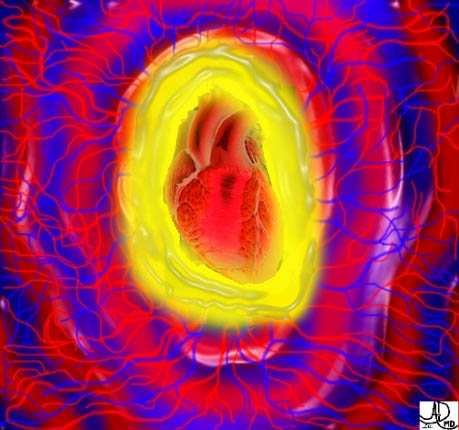In all of the HEART
when the PARTS are optimally
POSITIONED ,
they can CONNECT and can
FUNCTION together.
There is a
surprising and sometimes miraculous result
limited only by
TIME.
This is the beginning and the end of the story of the
HEART.

Artistic Rendition in Blue and Red
The Integrated Cardiac Module
AWARD Winner RSNA 2009
RSNA 2009
Purposes/Aim
1) To take the user from the word “heart” via a progressive, logically organized, integrated knowledge base, to the most complex information of the heart.
2) To emphasize basic principles as a starting point for complex information.
3) To utilize images liberally and in every form to enhance the understanding of information.
4) To integrate the basic sciences and clinical sciences in one web based source. Integration enables multiple perspectives of information, subtends understanding and results in true knowledge base of all aspects related to the heart.
5) To create a dynamic and adaptable learning environment that is able to change and grow over time.
6) To enable an arborized and easily navigable system.
|
Artistic Rendition in Blue and Red |
|
Davidoff art copyright 2009 Courtesy Ashley Davidoff MD 87180b11b11.8S |
Content Organization
“The Integrated Cardiac Module” provides a web based knowledge system, which starts with the basic sciences, and progressively connects the clinical information in one comprehensive source. Each of the disciplines is treated separately and integrated into the whole module. The viewer will learn about the cellular makeup, embryology, anatomy, pathology, imaging, and clinical disciplines. The addition of historical events adds richness to the program.
Summary
Integrated knowledge of the basic sciences with the clinical disciplines is essential to the practice of quality medicine. The content spans embryology, histology, anatomy, physiology, pathology, radiology, and clinical aspects. The infrastructure is organized around basic principles which progressively advance to more detail complexity. Four basic phases in embryology are used to understand detailed anatomy and the pathogenesis of congenital heart disease for example. Normal size and shape and their changes in the disease and manifestations in imaging are other examples. An image library of over 2000 images, power point presentations, and selected links to internet sources provide integrated depth and breadth.
The Common Vein
“Integrated Cardiac Module” is part of a larger project called The Common Vein (thecommonveincom) which is an educational program that approaches complex information by starting with the principles of medicine. The organizational pattern is consistent throughout the program, is organ based, with the knowledge base for each of the organs starting out with a simple definition that incorporates the essence its structure, function, disease, diagnosis and treatment . Each of these advances progressively in stepwise complexity, resulting in an arborised but integrated knowledge base. Principles are continually emphasized and images are used extensively.

The Heart Marvel of Nature |
|
In an average lifetime, the heart beats more than two and a half billion times. This is a unbelievable feat of nature. Courtesy of Ashley Davidoff M.D. 32061 code cardiac heart circulation artery vein introduction drawing Davidoff art |
